Photographs and image scan by the author. The illustrations of the Diwan-i-Am and Moti-Masjid are reproduced from pages in Sir Thomas Metcalfe's Reminiscences of Imperial Dehlie (1844), courtesy of the British Library, which has very kindly allowed us to use images from its Online Gallery. Please see the bibliography at the end, and visit the Library's own site for conditions of reuse. You may use the other images without prior permission for any scholarly or educational purpose as long as you (1) credit the photographer or source and (2) link your document to this URL in a web document or cite the Victorian Web in a print one. [Click on all the images to enlarge them.]

A view inside Red Fort, Delhi, as it is today. From left to right: the Moti-Masjid (the Pearl Mosque), the Hammam (Bath House), the Diwan-i-Khas (the Emperor's private audience hall), Khas-Mahal (the Emperor's private palace, with domed chattris), and just the edge of the Rang-Mahal (the Palace of Colour).
After suffering heavy losses during their long siege of the city, the British finally stormed the royal palace in Delhi on 20 September 1857. It was a few days after the Emperor had fled, but they were not aware of that. Some rebellious sepoys, proving themselves "worthy of the British officers under whom the greater number had been trained," put up a desperate last-minute stand:
A sentry ... awaited death at his post, and ... in a long passage crowded with wounded Native soldiers [i.e., Chatta-Chowk], a private, 37th Bengal Infantry, stood motionless at "The Ready" till the stormers were near, when, levelling his musket, he fired; then, charging, he met death on the bayonets of the King's Royal Rifles. [Wood 127]
Under such conditions, the British troops had no time or inclination to admire what they found inside the palace walls. Ruining the Emperor's elaborate formal gardens, they cleared the ground that had been used by the defeated rebels, and destroyed the harem courts and gardens to the west as well. They demolished the connections between the main buildings, and stripped the buildings themselves of their lavish decorations and treasures to replenish the army's, and no doubt in many cases their own, coffers.
However, they left intact the beautiful white marble Moti-Masjid or Pearl Mosque, seen on the left above, and found uses for the other large buildings, and these remain to give a hint of past splendours. The bulbous dome seen behind the last two buildings on the right is that of the Muthammam-Burj, the tower on the eastern wall where the Emperor used to appear to his subjects in a morning ceremony. Its original gilded copper cladding, like that of the Moti-Masjid domes, was removed in 1857, and the present dome is merely plaster. But it was nevertheless on the balcony here that George V and Queen Mary would appear to their Indian subjects at the Coronation Durbar of 1911 (see Red Fort, 54).
The Diwan-i-Am (Audience Hall)
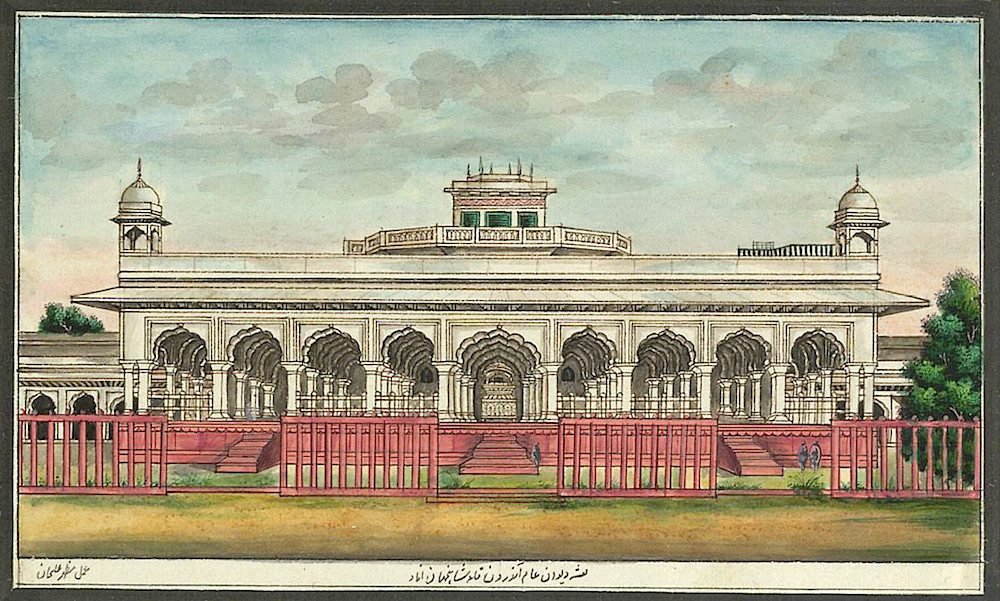
The Diwan-i-Am or Audience Hall, shown in ink and colours by a Company artist in 1840, in its former splendour ("The Diwan-i ‘Am from the west"). At this time its red sandstone was still overlaid with "shell plaster, ivory polished" (qtd. in Red Fort, 34).

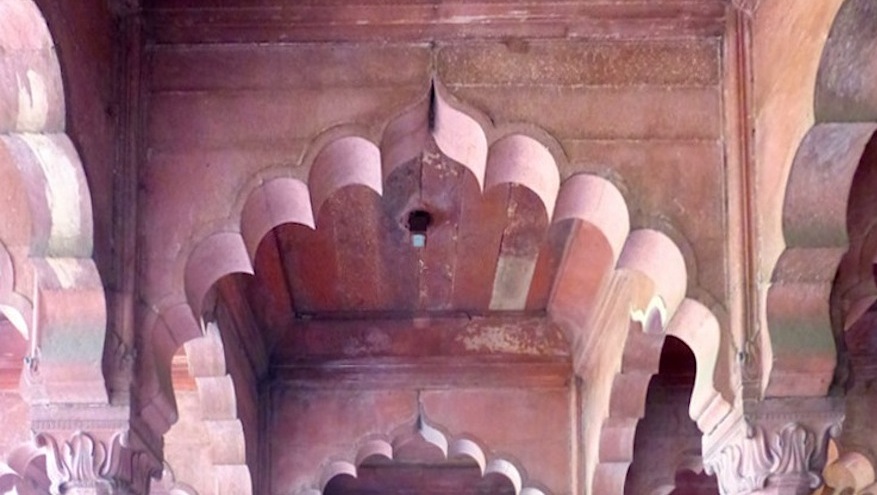
The gloriously ranked arches of the Diwan-i-Am today.
This building stands directly in line with the Lahori Gate and Drum House. Not shown in the photograph at the top, it follows on from the Rang-Mahal. It is striking even in its uncovered state. "Seen from any angle, the interiors of the Diwani-i-Am present a view of flowing curves, because of the presence of multiple arches" (Red Fort, 36).


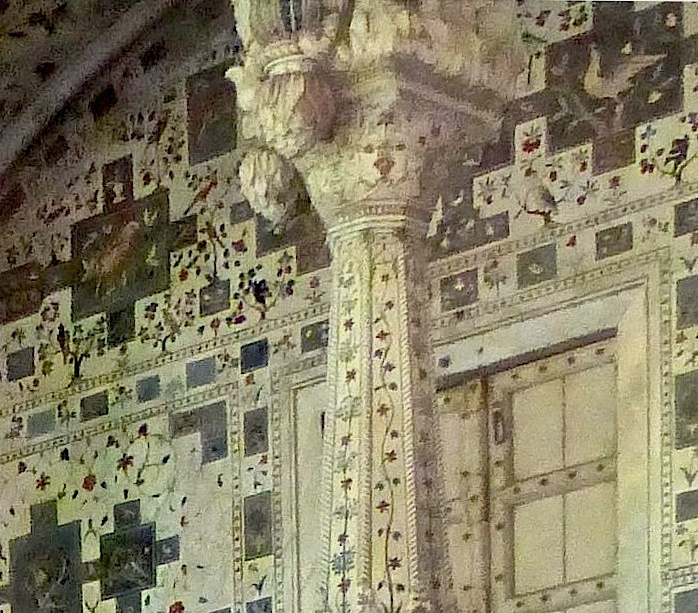
(a) The marble canopy under which the Emperor sat to give audience. (b) The last Mughal Emperor, Bahadur Shah Zafar II (1775-1862). Source: Dodd 69. (c) Part of the elegant back panel depicting birds and flowers of many kinds.
Of special interest in the Diwan-i-Am is the finely worked marble canopy under which the Emperor sat to give audience, making, as Emily Bayley would later put it, "a kind of opera box" (208). Now protected by glass panels, the canopy with its unusually bulbous columns decorated with twining vegetation is thought to show European influence. The detailed back panel certainly does: it incorporates Italian pietra dura work set in marble by a seventeenth-century Florentine jeweller. At its apex is a foot-high scene of Orpheus playing to enraptured animals, which was looted after the uprising but returned later at Lord Curzon's insistence (see Peck 189, and Red Fort, 39-40).
The Khas-Mahal (Emperor's Private Palace)
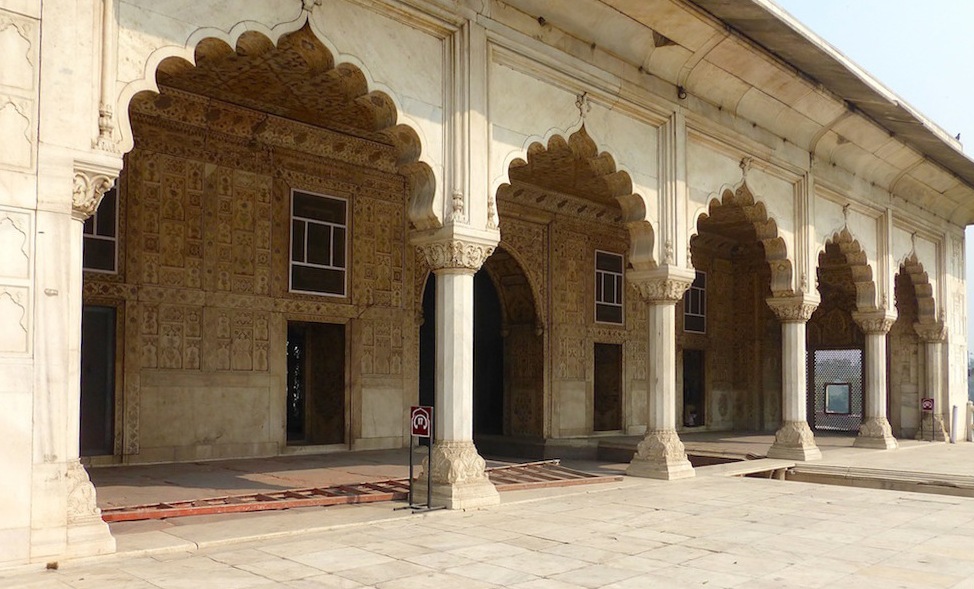
The exterior of the Khas-Mahal, the Emperor's private palace, in white marble with copious ornamentation.
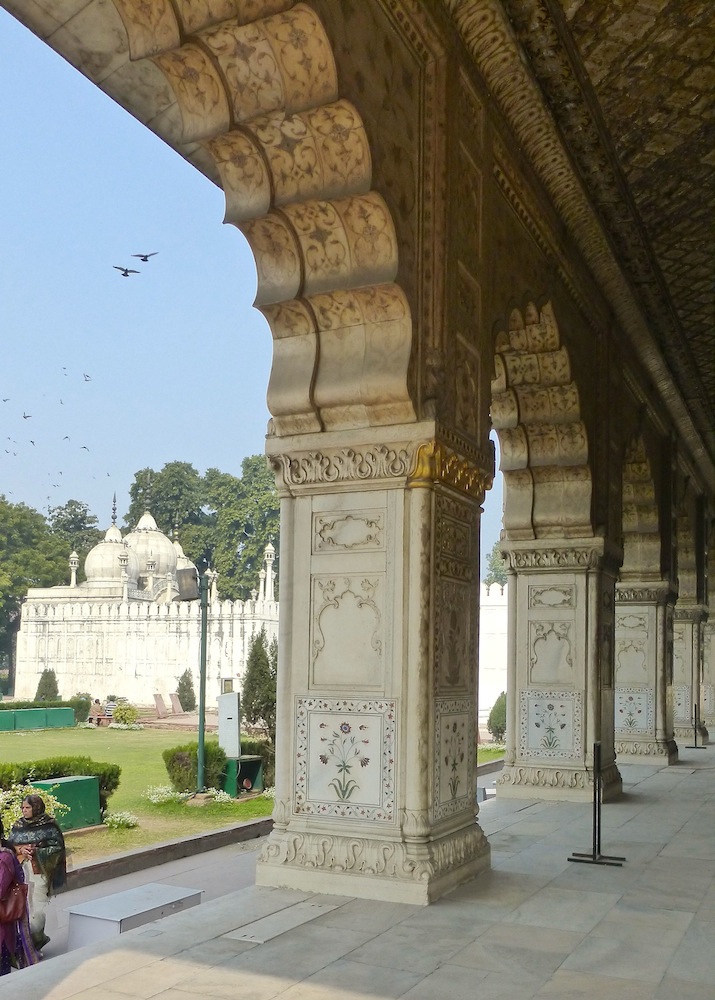
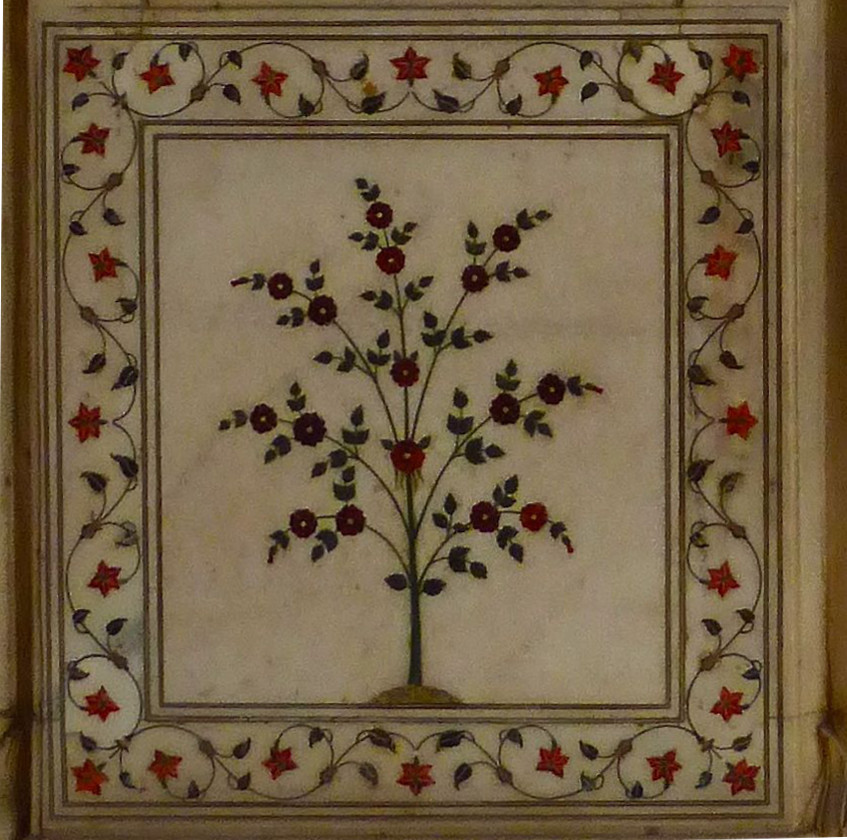

Left to right. (a) Close-up of the square columns of the Khas-Mahal, with their inlaid floral motifs on the square columns and right round the arches. (b) Close-up of a flower motif. (c) Within, the ornate Khas-Mahal screen.
The most precious item left in the Emperor's own suite is perhaps the screen at the south end, with its semi-circular panel depicting stars over a crescent moon, and the scales of justice. Below the panel is a lattice on a floral pattern, damaged now but still delicately beautiful. Water flowed through the marble channel beneath it.
While the Diwan-i-Am became the officers' lounge, after the British entry the emperor's personal entrance became a canteen (see Dalrymple 460). It was in this part of the Red Fort that the British troops, fresh from their victory, "drained goblets of wine to the health of her Majesty as Empress of India [already!], while a thousand triumphant voices shouted with fervour,'God save the Queen!'" (qtd. in Featherstone 120, from an account of 1859).
The Moti-Masjid (the Pearl Mosque)
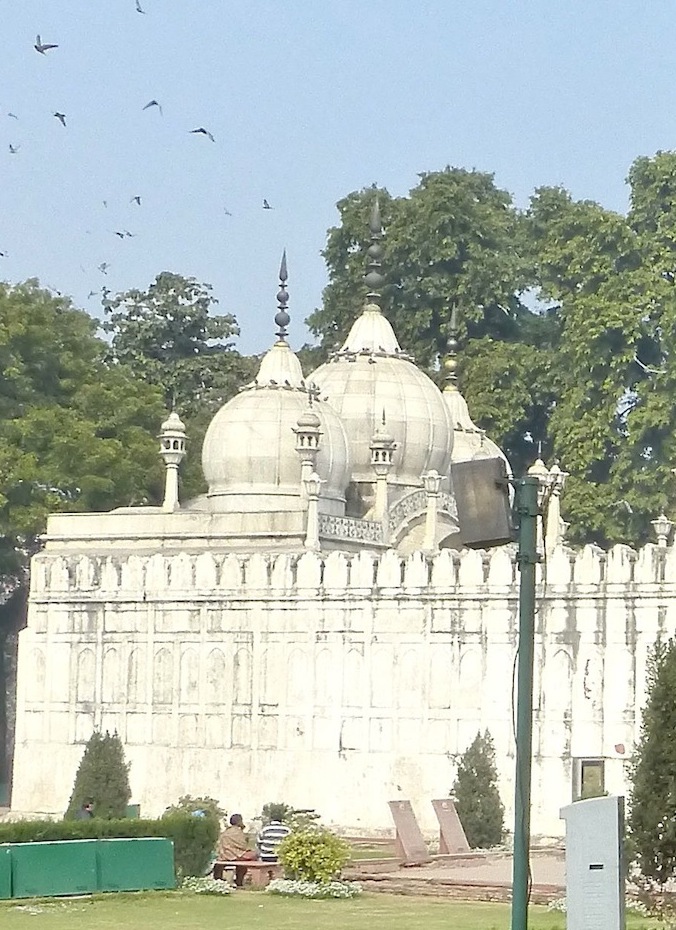


Left to right: (a) Partial view of the exterior of the Pearl Mosque. (b) Ink and colours illustration by a Company artist in 1844 ("Moti Masjid within the Palace"). (c) Highly decorated bronze door to the mosque.
The Pearl Mosque, added by Shah Jehan's son Aurangzeb, was where the women of the royal household could worship. Because of its high walled courtyard, it is hard to see to its best advantage, but Emily Bayley remembers it as "[o]ne of the most beautiful buildings in the Palace, indeed in all India." Though small, it "was a perfect gem of art and beauty," she says, made entirely of marble — even down to the courtyard walls, and all its interior arches were "inlaid with gold tracery." She believed the three domes to have been covered in gold as well, but in fact they were copper-plated (Red Fort, 67), then probably gilded. When the British moved in, she explains, the plating was removed "and sold for prize money for the benefit of the army" (208). The elaborately patterned bronze door, shown above right, either looked less valuable or was saved because it was not simply decorative but fulfilled a useful function.
Plunder, however regrettable, was probably inevitable at the time. But in the end the British were bound to take away something more lasting than "prize money" from magnificence like this. Clearly, "more than aesthetic considerations" were involved in planning new public buildings for the sub-continent (Metcalf 75). But the Indo-Saracenic architecture of the Victorian period need not be seen in a negative light. Those architects who used elements of Mughal design in their work, in India as elsewhere, can more fairly be seen as paying tribute to it than as (mis)appropriating it in order to bruit colonial conquest. In the world of design, as the Florentine pietra dura work in the Diwan-i-Am illustrates, the best of everything has always travelled across cultures.
Related Material
- The Lahore (or Lahori) Gate of the Red Fort (1889 engraving)
- The Red Fort, Delhi, in Victorian Times
- The Red Fort at Delhi: Walls and Gateways
- "The Epic of the Race": The Indian Uprisings of 1857
- British Army buildings at the Red Fort, Delhi
- Humayun's Tomb, Delhi
References
Bayley, Lady Emily. The Golden Calm: An English Lady's Life in Moghul Delhi, ed. M/. M. Kaye. Exeter: Webb & Bower, 1980. (This includes the Reminiscences of her father, Sir Thomas Metcalfe.)
Dalrymple, William. The Last Mughal: The Fall of a Dynasty, Delhi, 1857. Delhi: Penguin, 2007.
"The Diwan-i ‘Am from the west." British Library Online Gallery. Web. 26 February 2015.
Dodd, George. The History of the Indian Revolt and of the Expeditions to Persia, China, and Japan, 1856-7-8. London: Chambers, 1859. Internet Archive. Contributed by Robarts Library, University of Toronto. Web. 26 February 2015.
Featherstone, Donald. Victorian Colonial Warfare: India. London: Cassell, 1992.
Metcalf, Thomas. An Imperial Vision: Indian Architecture and Britain's Raj. Berkeley: University of California Press, 1989.
"Moti Masjid within the Palace." British Library Online Gallery. Web. 26 February 2015.
Peck, Lucy. Delhi: A Thousand Years of Building. New Delhi: Roli (Lotus), 2005.
Red Fort. Based on the text of Y. D. Sharma. Delhi: Archeological Survey of India (Goodearth Publications), 2009.
Wood, Sir Evelyn. The Revolt in Hindustan, 1857-59. London: Methuen, 1908. Internet Archive. Contributed by University of California Libraries. Web. 26 February 2015.
Last modified 26 February 2015